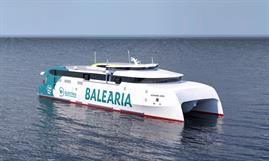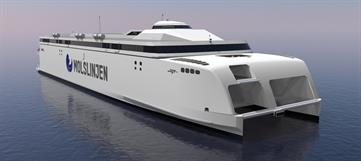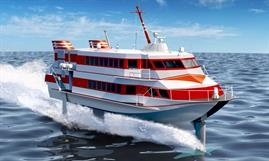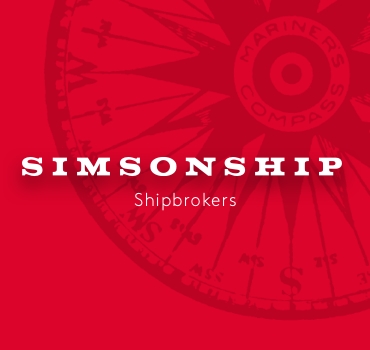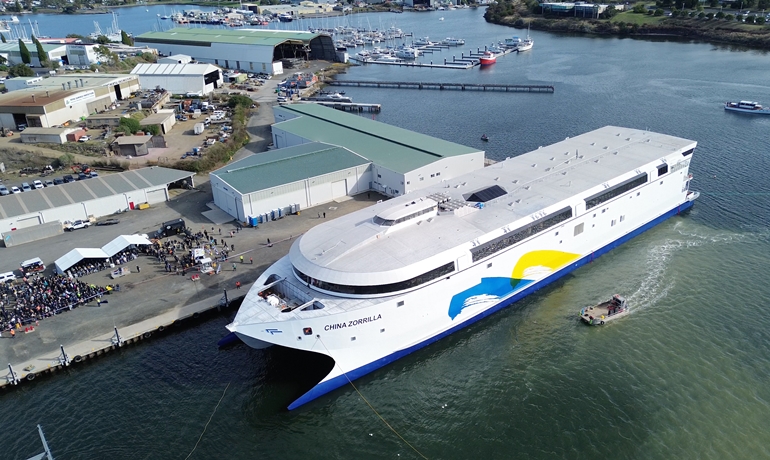
CHINA ZORRILLA © Incat
Incat launched CHINA ZORRILLA, the world’s largest battery-electric ship
High-speedHundreds gathered at the Incat shipyard in Hobart to witness as Incat Hull 096 - the world’s largest battery-electric ship - was officially launched.
Constructed for South American ferry operator Buquebus, Hull 096 is the most significant vessel ever built by Incat. When it enters service between Buenos Aires and Uruguay, it will operate entirely on battery-electric power, carrying up to 2,100 passengers and 225 vehicles across the River Plate.
“This is a historic day - not just for Incat, but for the future of maritime transport,” said Incat Chairman Robert Clifford. “We’ve been building world-leading vessels here in Tasmania for more than four decades, and Hull 096 is the most ambitious, most complex, and most important project we’ve ever delivered. This ship changes the game.”
The ship is the ninth Incat-built vessel for Buquebus, continuing a proud and long-standing partnership between the two companies.
“For me, it’s a true source of pride to see Buquebus’ vision come to life,” said Buquebus President Juan Carlos López Mena.
“When we were evaluating this new vessel, Robert Clifford told me, ‘The next ship I deliver to you will be 100% electric.’ I replied, ‘Then the next one must be the one we’re commissioning today.’ And with great courage, he said, ‘Together, we’re going to make history.’ That’s how we began reconfiguring the CHINA ZORRILLA - originally planned to run on LNG - into a fully electric vessel. It’s a true milestone achieved between private companies, driven by our commitment to sustainability and our ongoing pursuit of service excellence.”
The ship is equipped with over 250 tonnes of batteries and an Energy Storage System (ESS) boasting 43 megawatt-hours of installed capacity. The ESS, which is more than three times larger than any previous maritime installation in the world, is connected to eight electric driven waterjets and supplied by Wärtsilä.
“We are proud to have collaborated with Incat and Buquebus in launching the world’s largest battery-electric ship,” says Roger Holm, President of Wärtsilä Marine and Executive Vice President at Wärtsilä Corporation. “Ferries play a vital role in meeting the growing demand for environmentally sustainable transport options, with ship electrification a key solution for enabling the sector to transition towards net-zero emissions.”
“We’re not just building a ship - we’re building the future,” said Incat CEO Stephen Casey. “Hull 096 proves that large-scale, low-emission transport solutions are not only possible, they are ready now. This is a proud day for Tasmania and for Australian manufacturing.”
Work will now continue completing the vessel’s interior, which includes a 2,300 square metre duty-free retail deck - the largest shopping space on any ferry in the world. Final fit-out, battery installation, and energy system integration will take place ahead of sea trials later this year on the River Derwent.
At 130 metres in length, Hull 096 is not only the largest electric ship in the world, but also the largest electric vehicle of its kind ever built - and one of the most significant single export items in Australia’s manufacturing history.
“This ship puts Tasmania and Australia firmly on the world stage,” Clifford added. “We’re incredibly proud of what our team has achieved - and this is only the beginning.” ,
© Shippax
maj 02 2025
Most read
Incat Tasmania and Molslinjen sign contract for third battery-electric high-speed catamaran
dec 05 2025


